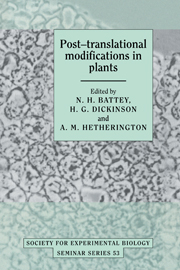Book contents
- Frontmatter
- Contents
- List of contributors
- List of abbreviations
- Preface
- Some roles of post-translational modifications in plants
- Signal transduction and protein phosphorylation in bacteria
- Roles of protein phosphorylation in animal cells
- The significance of post-translational modification of proteins by phosphorylation in the regulation of plant development and metabolism
- Post-translational modification of chloroplast proteins and the regulation of protein turnover
- Purification of a small phosphoprotein from chloroplasts and characterisation of its phosphoryl group
- Use of synthetic peptides to study G proteins and protein kinases within plant cells
- Activation of membrane-associated protein kinase by lipids, its substrates, and its function in signal transduction
- Distribution and function of Ca2+-dependent, calmodulin-independent protein kinases
- Phosphorylation of the plasma membrane proton pump
- The regulation of phosphoenolpyruvate carboxylase by reversible phosphorylation
- Protein phosphorylation and circadian rhythms
- Control of translation by phosphorylation of mRNP proteins in Fucus and Xenopus
- Regulation of plant metabolism by reversible protein (serine/threonine) phosphorylation
- Detection, biosynthesis and some functions of glycans N-linked to plant secreted proteins
- Biosynthesis, intracellular transport and processing of ricin
- Post-translational processing of concanavalin A
- The role of cell surface glycoproteins in differentiation and morphogenesis
- Ubiquitination of proteins during floral development and senescence
- Index
Control of translation by phosphorylation of mRNP proteins in Fucus and Xenopus
Published online by Cambridge University Press: 06 July 2010
- Frontmatter
- Contents
- List of contributors
- List of abbreviations
- Preface
- Some roles of post-translational modifications in plants
- Signal transduction and protein phosphorylation in bacteria
- Roles of protein phosphorylation in animal cells
- The significance of post-translational modification of proteins by phosphorylation in the regulation of plant development and metabolism
- Post-translational modification of chloroplast proteins and the regulation of protein turnover
- Purification of a small phosphoprotein from chloroplasts and characterisation of its phosphoryl group
- Use of synthetic peptides to study G proteins and protein kinases within plant cells
- Activation of membrane-associated protein kinase by lipids, its substrates, and its function in signal transduction
- Distribution and function of Ca2+-dependent, calmodulin-independent protein kinases
- Phosphorylation of the plasma membrane proton pump
- The regulation of phosphoenolpyruvate carboxylase by reversible phosphorylation
- Protein phosphorylation and circadian rhythms
- Control of translation by phosphorylation of mRNP proteins in Fucus and Xenopus
- Regulation of plant metabolism by reversible protein (serine/threonine) phosphorylation
- Detection, biosynthesis and some functions of glycans N-linked to plant secreted proteins
- Biosynthesis, intracellular transport and processing of ricin
- Post-translational processing of concanavalin A
- The role of cell surface glycoproteins in differentiation and morphogenesis
- Ubiquitination of proteins during floral development and senescence
- Index
Summary
Introduction
The study of plant gametogenesis, fertilisation and embryonic development has been hindered by the inaccessibility of the gametes and embryo in higher plants. It has therefore been necessary to turn to lower plants as model systems for studying these early phases of development. Large brown marine algae of the genus Fucus have been used extensively for this purpose (Quatrano, 1990). This and another recent study (Masters, Shirras & Hetherington, 1992) provides evidence that the eggs of Fucus serratus contain maternal mRNA and that this mRNA may be sequestered in mRNP particles in a manner similar to that found in several animal systems. Further, as previous work has demonstrated that phosphorylation–dephosphorylation of messenger ribonucleoproteins plays a role in the control of the translational availability of Xenopus stored mRNA, we have sought evidence that a similar strategy is employed in Fucus eggs.
Maternal mRNA
The unfertilised Fucus egg shows no apparent asymmetry, an axis of symmetry forming after fertilisation in response to external stimuli such as light. When unidirectional light is shone on Fucus zygotes the shaded side forms a protuberance. The first cell division is asymmetric, dividing the protuberance from the larger cell mass of the original zygote. The polarisation of the embryo can be divided into two phases: a reversible axis formation and an irreversible axis fixation. Axis fixation depends on a reorganisation of actin filaments and an interaction between cell surface molecules and the forming cell wall (Kropf, Kloareg & Quatrano, 1988; Kropf, Berge & Quatrano, 1989a).
- Type
- Chapter
- Information
- Post-translational Modifications in Plants , pp. 187 - 196Publisher: Cambridge University PressPrint publication year: 1993



